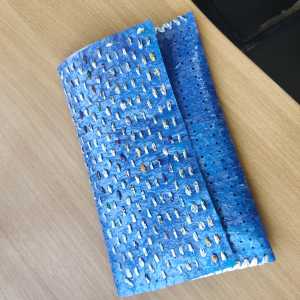While looking into ideas for a workshop, I returned to some Kugurizashi-ish samples I’d created a while ago (Kugurizashi is a form of Sashiko where designs are created by needle weaving thread through rows of running stitch). This has led down a bit of a rabbit hole of looking at other forms of surface-woven embroidery, specifically Indiam Kolams, and I think I’ve learnt enough stuff that it’s worth making a list of ideas and links for the benefit of future me and perhaps others too.
I think my interest in all this started during lockdown, when I was trying out some of the ideas in US teacher Annie Perkins’ #MathArtChallenge which is full of interesting and accessible ideas for Math Art. After looking at these Hitomezashi grids, I thought this could be a way of including sun-reflecting surfaces in clothing and put together this clutch bag with other members of Plastic Tactics (a CIC I’m involved in which looks at fun ways of recycling plastics).

This project was created from bubble wrap and carrier bags, heat pressed together and laser cut with a grid of holes. Monster Munch packets were sliced into thin sections and twisted to form a yarn which could be sewn in and out of the holes to form a Hitomezashi pattern (one thing we found out was that sewing Monster Munch yarn through small holes hurts your hands, so we only managed to sew it in one direction in the end).
I also had a go at hand-sewn Sashiko at a relaxing WI class run by Liz Taylor, and, looking for a faster result, machine embroidering Sashiko-style patterns onto heat pressed bubble wrap using the Sashiko Inkscape extension, which allows you to choose from a range of traditional Sashiko stitches.

I loved this result, but I felt other users weren’t sure about using a shared embroidery machine with plastic - it’s a great way to get small scale Sashiko-style patterns for fabric clutch bags though.
Next, and fairly accidental step forward - DoES Liverpool did a Textiles Takeover at Tate Liverpool X RIBA North gallery earlier this year, where one of the activities was Liz’s Sashiko. There was a concern that small children would want to take part, and not be able to use sharp needles, so I laser cut some square grids from decorative card, that could be used with blunt needles. No small children took part, and the grids didn’t get used! After the event, I sewed some of them with Kuguruzashi-style stitching.

I used the coloured examples on birthday cards. The grey one is sewn using conductive thread and works well as a capacative touch sensor. Stitching on card doesn’t give the pillowed effect you get on fabric, but running your fingers over the raised stitches is a good tactile feeling. Having given these examples away I had to make some more for this sample accordian book that I made for a potential workshop next year.
All this Sashiko-related experimentation then led me on to Indian Kolams, which researchers Anu Reddy and Alex McLean had looked at sewing on to Sashiko-style grids in the same ways as Kuguruzashi. I feel I’ve just got started on this topic, but here’s some examples I’ve created so far.

This is a simple Kolam woven into a Hitomezashi Sashiko grid. Kolams normally have rounded edges, but this comes out very blocky due to the grid.

Here I used a cheap LED strip (not quite long enough) on a plastic mesh, with cable ties to fix the Kolam in position. The result looks less blocky due to the LED strip being less flexible than the yarn in the previous example. I’d like to try this with LED noodles with light all round, although the dark patches are interesting.

Anu and Alex give instructions for producing a machine-embroidered grid on this page. Once I eventually read them I was able to produce the above grid and copied one of their examples to weave a Kolam into it. The result is very pretty and has lots of decorative potential.
I’m working on a completely different project this week but looking forward to getting back to some more of this, possibly including pen plots.
